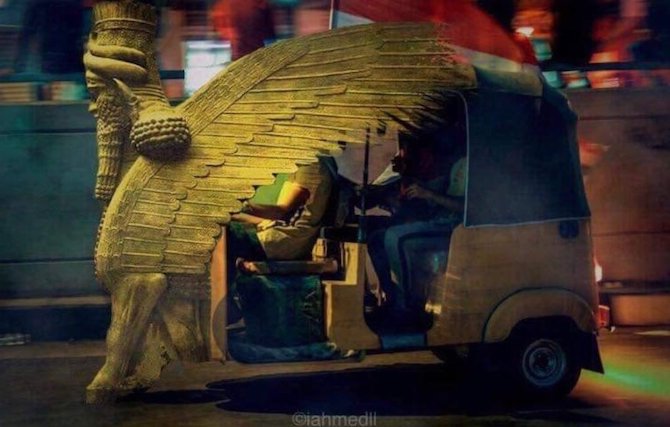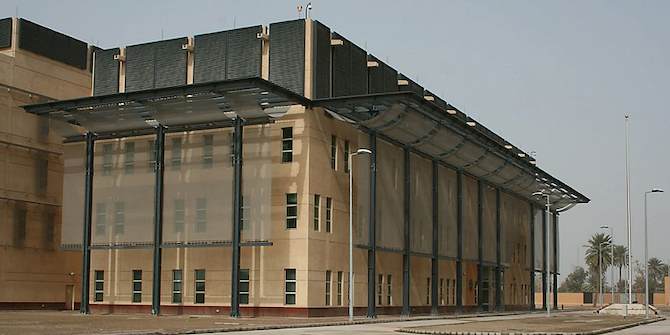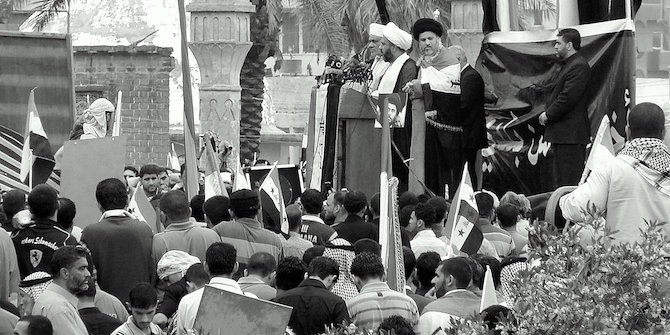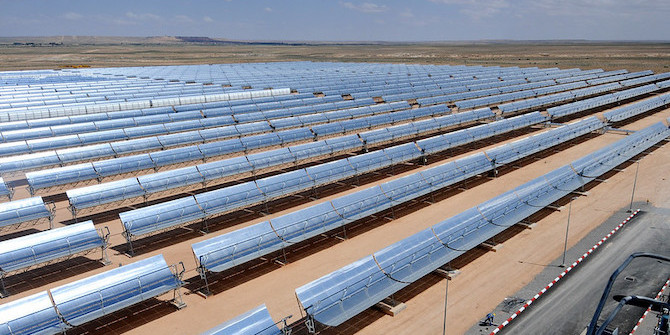by Christine McCaffray van den Toorn and Raad Alkadiri

Six weeks into the latest unrest in Iraq, protests in Baghdad and the southern provinces show no sign of abating. What began in the capital in early October as relatively small demonstrations bemoaning a lack of jobs and government corruption has turned into something far bigger and far-more consequential: a fully-fledged social movement-cum-revolution demanding a nothing less than a nation, and a root-and-branch reform of the political system. Led by young Iraqis who have come of age since 2003, and who feel utterly let down by a state that seemingly ignores their welfare and future, protestors want wholesale change in how Iraq is ruled and who is ruling it. This is now a battle for the soul of the Iraqi state, and one that is arguably far more consequential than most of the military operations fought since 2003.
The scale of the protests, and the bravery of the protestors in the face of a sometimes-brutal government response, illustrate their desperation and their fortitude. Daily scenes from Tahrir Square in Baghdad, the epicentre of the demonstrations, show people of different classes and social backgrounds coming together in huge numbers to support the protest movement and sustain them in any way they can, via whatever contribution they can make. In the process, they have erected a mini-city, complete with electricity, services, healthcare and even barber shops.
Make no mistake, this is a grassroots uprising of angry and frustrated Iraqis in the Shia heartland of the country, the supposed bedrock of the post-2003 regime, who see popular protest as the only way left to them to bring about meaningful change to their lives. And they have the bit between their teeth. Any fear or complacency that held them back in the past is no longer there; just witness the rising death toll. The genie is out of the bottle, and it cannot be put back.
Iraq is at a stark crossroads, and there are no easy answers to resolve the current standoff between rulers and the ruled. The underlying issues driving the protests – the lack of prospects, of a state that cares, of dignity, and the pervasive corruption and incompetence of successive government – are all structural, the product of 16 years of mismanagement of the state by a self-serving political elite that was put in power in 2003 and has never been held accountable since.
Iraqis are now making it clear that enough is enough. The demonstrators want meaningful action, and they want it quickly. Their demands are bold but straightforward: the resignation of the current government and its replacement by an interim administration that will prepare the ground for new, internationally supervised elections; a new election law that establishes more, smaller electoral districts than the current 18 province-level ones, replaces proportional representation with a first-past-the-post system, and with candidates standing as individuals not representatives of political parties; an independent investigation into the violence used by security forces during the protests (which has led to over 250 deaths and more than 11,000 injuries so far); rapid constitutional reform; and a massive anti-corruption campaign that encompasses the whole political elite.
But the government is showing little sign of budging. Its response so far – a mixture of short-term spending measures that it cannot afford or implement effectively, promises of long-term reform that a cynical population no longer believes it will implement, and brutal repression – suggest that it either does not fully appreciate just how angry its citizens are, or that it does not care. The recent announcement by the Iraqi Chief Justice that demonstrators blocking roads to government buildings will be charged as terrorists highlights just how divorced it is from the protestors. Repeated platitudes by government leaders justifying the status quo, combined with a campaign of intimidation and violence, are not going to solve the problem; instead, it will simply add fuel to the fire raging the bellies of demonstrators.
There have been some exceptions. President Barham Salih has publicly acknowledged the legitimacy of the protestors’ complaints and has proposed a new electoral (only to be tarnished with allegations of treason as a result). Muqtada al-Sadr has called on the government to resign, while former Prime Minister Haider al-Abadi has voiced support for reform. Among the political parties, the Communist Party withdrew from the Council of Representatives. However, the rest of the government, associated militias, and most of the political class in general have either fallen back on conspiracy theories to explain the unrest (characterising the demonstrations as a US/Israeli/Saudi attempt to unseat the Iraqi government) or toed the government’s line by paying lip-service to the legitimacy of the protestors demands but little more.
The big question is: where do the protests go from here? If they continue to spread with neither side giving ground, and especially as some protestors move towards civil disobedience, blocking main bridges, some oil fields and the post at Umm Qasr, there are worrying signs that the government, backed by Iran, may try to quash them by force by announcing a state of emergency in the country. The result is likely to be massive bloodshed, and – beyond that – the emergence of a new security state in the Middle East that suppresses popular opposition through government-sanctioned intimidation and violence. Hardly what Washington envisaged when the US-led coalition removed Saddam.
But with 2–300,000 people gathering daily in Tahrir Square alone, violence may not work. The government has force of money and arms on its side. However, the lesson of the Arab Spring and more recent popular movements in Algeria and Sudan is that unpopular regimes – even ones willing to use force – struggle to stay in power once protests reach a certain critical mass and no avenue for compromise is offered.
Do the protestors have the level of organisation and coordination required to force a determined regime to give way? Possibly. With unions and civil-society organisations now heavily engaged in the protest movement, its foundations are arguably more robust. Meanwhile, cells of organising committees are acting behind the scenes to direct protests and maintain logistical support to sustain them in the long term.
Whether the protestors have solutions to fix the problems of governance, welfare, administration and corruption if they do win out is another question entirely. Protest leaders have not yet offered any clear action plan for how to implement change, partly because they are not demanding a new state, just one that works better. Local sources suggest that some serious thinking is being undertaken as to how this goal can be achieved, but that it remains a work in progress.
This shortfall will need to be addressed quickly. If the demonstrators do unseat the government, coming up with a workable plan to make government more accountable, institutions more effective, and to promote the rule of law and combat corruption, will be vital to maintain the momentum for change. The disappointments of the Arab Spring are stark proof that, once regime change happens, it can leave a destabilising vacuum if there are no answers to the ‘what next?’ question. The resulting chaos diminishes popular support for change, and makes revolutions prey to being co-opted by established parties and political forces. In other words, Iraq could go back to square one.
One way to avoid this fate may be if protest leaders are able to establish a bridge to the few current Iraqi leaders who fully support change, and to work with them to find reform solutions. There is certainly the appetite among that small minority of Iraqi officials who understand that reform is vital. The fact that protestors are not intent on replacing the foundations of the state entirely, and are willing to preserve the working parts of the current system, makes this option even more viable if the two sides can be brought together.
Joint action offers no panacea or guarantees of long-term stability. A common vision of the state would need to be agreed; difficult constitutional issues related to sovereignty, power-sharing, governance and representation would need to be addressed; and broad buy-in from all of Iraq’s communities would need to be secured. These issues have bedevilled Iraq for 16 years without resolution, and there are plenty of parties and leaders who are happy with the current ambiguity.
But if workable answers to these challenges can be found, Iraqis will face a brighter future. The protests have already achieved something momentous; modern Iraq has never seen a popular mass movement on this scale before. If they can find a way to build on their success, they may be able to establish the basis for effective long-term governance and a stable state that benefits the population at large in a way that the US-led coalition and the parties it empowered failed to do after 2003.






